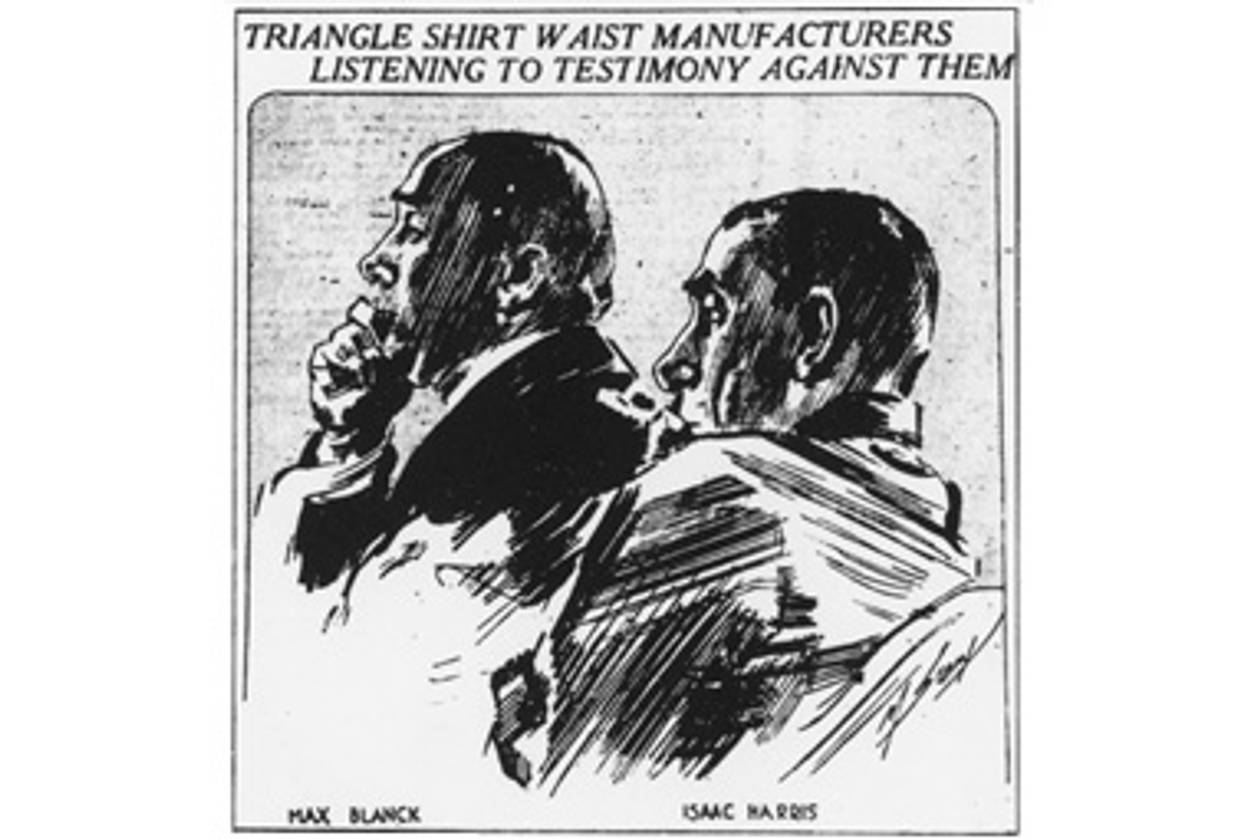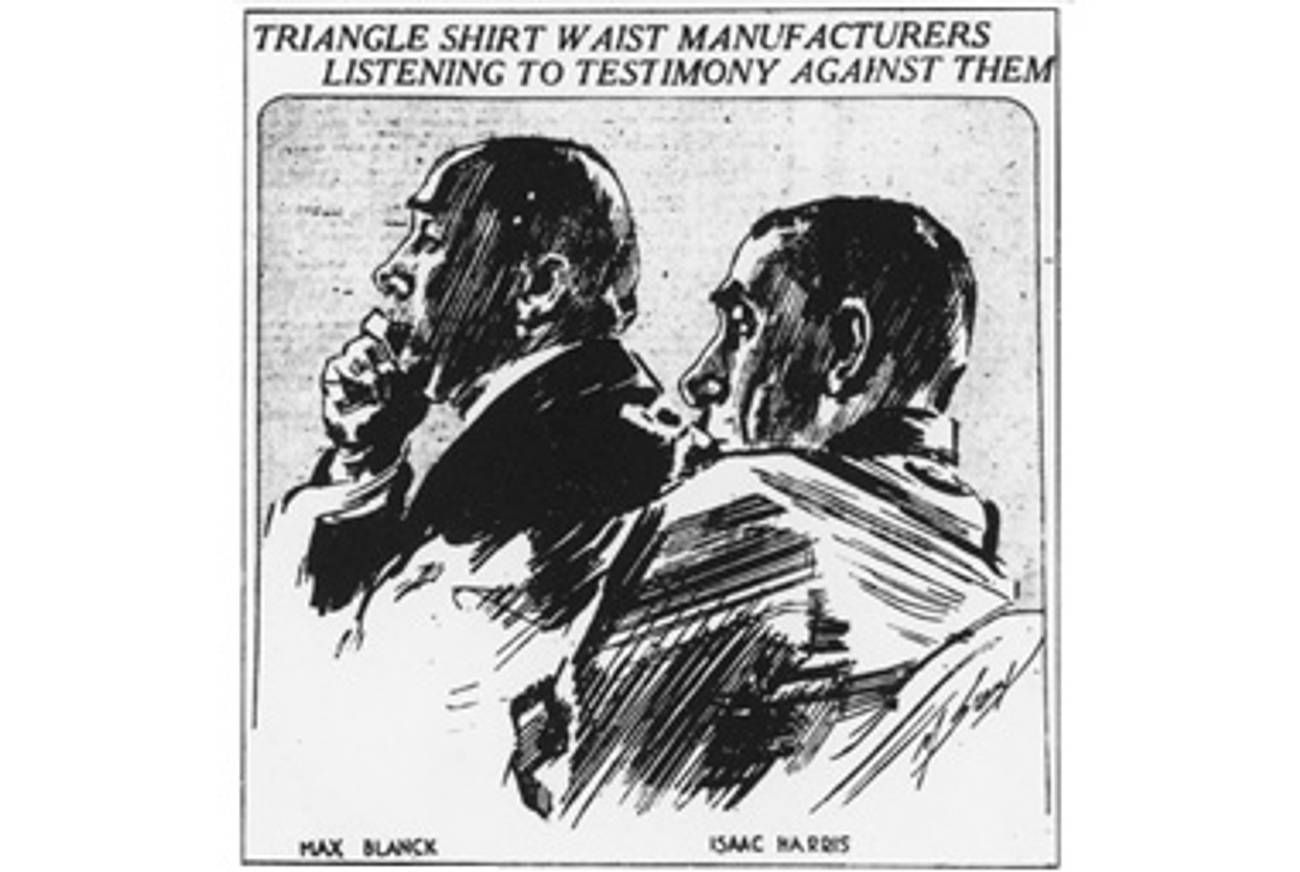Lost in the Fire
On the 100th anniversary of the Triangle Shirtwaist Factory fire, it’s important to remember this important case not as a black-and-white morality tale but as a nuanced and complex story




A few years ago, I discovered that my husband was related to Max Steuer, the criminal-defense lawyer who represented the owners of the Triangle Shirtwaist Factory. In 1911, a fire at the factory killed 146 garment workers. The owners, accused of manslaughter, got off scot-free. And I felt a little queasy. As the story goes, those owners, Isaac Harris and Max Blanck, were wealthy, privileged titans of industry. Most of the victims were poverty-stricken young Jewish and Italian girls. At first blush, it was a simple story of good and evil.
My younger daughter’s name is also Max Steuer. (It’s short for Maxine, but we usually call her Max or Maxie.) The older Max Steuer looked unnervingly like my husband—same hooded almond-shaped eyes, heavy brows, strong nose, prominent chin. This was not a familial connection I wanted.
But now I think different. I think Steuer, Harris, and Blanck have been mistreated by history.
How, you may ask, can a feminist obsessed with workers’ rights and immigration history, someone who participates in Triangle memorial events every year and bores her coworkers with endless rambling about the fire, say such a thing? Because while black-and-white depictions of heroes and mustache-twirling villains may make for better storytelling, they hinder our understanding of what really happened on March 25, 1911. And more important, they prevent us from seeing essential parallels to the world we live in now.
Susan Harris, 62, knows this well. She is the granddaughter of Max Blanck. “When I found out about the fire I was probably 15,” she told me. “I found Leon Stein’s book in my parents’ library and saw my grandfather’s name, and thought this couldn’t be my grandfather. But it was.”
The book’s portrayal of her grandfather shook Harris. Though he’d died before she was born, she knew how much money he’d given to charity. She knew from her parents and cousins how loving he’d been. Blanck, in short, didn’t seem like the monster popular history suggested he’d been; researcher Michael Hirsch, Harris soon learned, supported her theory that her grandfather and his fellow owner were scapegoats.
“They were scapegoats of a system that didn’t want to pay attention to the mechanisms of the time,” said Hirsch, a co-producer of the HBO documentary Triangle. “Blaming Harris and Blanck took people’s attention away from corruption in City Hall, Tammany Hall, and the buildings department.” Vilifying Harris and Blanck, Hirsch added, was a way to avoid “killing the golden goose” and changing a system that worked for the powerful.
The Blancks, Hirsch pointed out, lost more family members in the fire than anyone else. “Their relatives worked in every corner of the factory,” he said. “They had greenhorn relatives, wealthy relatives, old patriarchs of the clan working at machines. Max Blanck’s wife, Bertha, lost her own brother. Blanck and Harris brought many relatives to America, saving them from the Kishinev pogrom, giving them jobs.” But no one wanted to humanize the owners. Which means we missed a teachable moment.
“The real story is more fascinating and more timely, especially right now when we’re talking about rolling back all our social safety nets,” Hirsch said. “I don’t think Harris and Blanck are blameless, but it was never proven in the court case that the doors were locked, and we will never know for sure.”
Turning the fire narrative into a simplistic fable means forfeiting the chance to look at the changes the fire wrought and what it didn’t. “What happened 100 years ago this week should be an opportunity to talk about what’s going on today in Wisconsin,” Harris said. Hirsch agreed. “The takeaway should be that we need government to play a role in our lives,” he said. “The reason those people died was because government refused to play a role in regulating anything, in creating any kind of safety net for people. The very day of the fire, newspapers had reported that the high court had struck down New York State’s workman’s comp law, the most sweeping such law in the country. How much has really changed?”
For a long time, Harris struggled with her feelings. She was afraid to reach out to other descendants of Triangle families, worried about being shunned. So, she quietly addressed her family’s legacy in her own way. An artist in Los Angeles, she began working on a project about the fire three years ago. She collected dozens of Edwardian shirtwaists—the same type of garment the factory had once manufactured—and other fabric fragments and began embroidering the names of the victims upon them. Today, the piece is 152 feet long.
Harris collected the fabric on eBay and in antique stores. “In addition to shirtwaists I use handkerchiefs—symbols of sorrow,” she said. “Some are wedding handkerchiefs, because many of the girls were engaged to be married. I use babies’ clothes, because women left their children to go to work and never returned home.”
Eventually, Harris reached out to the families of victims and found that most were welcoming. She began asking them if they wanted to embroider their own relatives’ names on her work. Many took her up on it. “I’d mail them the fabric with a needle and embroidery thread and they’d send it back,” she recalled. All the shirtwaists and handkerchiefs have been strung up on a line so that they resemble Tibetan prayer flags. Starting on March 26, they will hang above the vintage engines in the 1904 firehouse that houses the New York City Fire Museum. The installation runs through April 23.
The fire feels like part of her DNA. “There’s a certain sorrow that’s in your blood, your genes,” she said. “I live with this happy-sad feeling all the time. There’s this wonderful feeling of gratefulness to be alive, but there’s sadness for my grandparents and all the victims’ families. Making the prayer flags has been a healing for me. I want everyone to be healed.”
Just as Susan Harris’ grandfather shouldn’t be remembered as a cartoon bad guy, neither should Max Steuer, said Hirsch. True, he was a virtuoso of the courtroom. I knew that his cross-examination of Kate Alterman, one of the survivors, is still studied in law schools today. Steuer gently had Alterman give her testimony four times, and the jury gradually realized that she was repeating herself almost verbatim. Phrases kept recurring: “The trail of her dress and the ends of her hair began to burn,” “a big smoke came” “a red curtain of fire,” a young man jumping “like a wildcat” at the window. Steuer cast suspicion on the prosecution for coaching the witness. But Hirsch added that Steuer actually may have known the testimony was wrong. “I’ve found a detailed floor plan, and I really don’t know how Kate Alterman could have seen what she claimed she saw,” Hirsch said. “It’s hard to imagine racing from the Greene Street door to the Washington Place door and back again, given how fast the fire spread, how narrow the space between tables was and how the tables were bolted to the floor.”
Furthermore, Hirsch added, Steuer was no enemy of workers. He worked against child labor throughout his life. Famed labor leader Sidney Hillman was a pallbearer at his funeral. And according to a 1932 book, Max Steuer: Magician of the Law by Richard O. Boyer, he didn’t always serve the powerful. “To the 450,000 depositors who lost their savings in the financial debauch that was the Bank of United States failures, he was a white knight fighting for the rights of the poor against the monied interests,” Boyer wrote. This portrait of Steuer is hard to square with the Machiavellian man cross-examining a hapless fire victim.
Lynn Steuer, 73, is Max Steuer’s granddaughter (and a distant cousin of my husband.) He died when she was 3. “I remember we used to go to my grandparents’ townhouse every Sunday for lunch,” she said. “He would pinch my cheek and it would hurt, and my mother would say, ‘You have to put up with it! He’s your grandfather!’ ” And like Susan Harris, Lynn Steuer learned about the fire on her own. “It’s like a word you see in a book and know what it means even if you don’t know how you know,” she said. Again like Harris, she thought she’d be persona non grata at Triangle events. But she decided to attend one and felt welcome. “The only good thing about the fire,” she said, “was the change in labor laws that came out of it.”
Unfortunately, that change doesn’t always feel lasting or meaningful. Think about the horrid conditions—and child workers—in certain kosher slaughtering houses. Think about the myriad safety violations that predated the Sago Mine disaster. Think about the Deepwater Horizon crisis. Michael Hirsch watched it unfold while he was working on the HBO film. “I watched an interview with a foreman on the oil rig who said that before he was allowed to eat or bathe, he was pressured to sign a statement that there was nothing wrong on the rig. He also said that after the explosion he was trying to decide whether to die by burning or by jumping. When I heard that, I was frozen. It was the same choice people had to make 100 years ago. It was Triangle. It was Triangle all over again.”
That’s ultimately why we need to stop reducing a nuanced story to simplistic tropes and two-dimensional villains. Because it means we’re not focused on how to keep Triangle from repeating itself.
***
The victims of the fire at Triangle Shirtwaist Factory came from Manhattan’s Lower East Side, Greenwich Village, and Harlem, Brooklyn, and Hoboken, New Jersey. Click on each dot to view the name, age, and residential address of every victim.
John Schimmel/Remember the Triangle Fire Coalition
Marjorie Ingall is a columnist for Tablet Magazine, and author of Mamaleh Knows Best: What Jewish Mothers Do to Raise Successful, Creative, Empathetic, Independent Children.
Marjorie Ingall is a former columnist for Tablet, the author of Mamaleh Knows Best, and a frequent contributor to the New York Times Book Review.